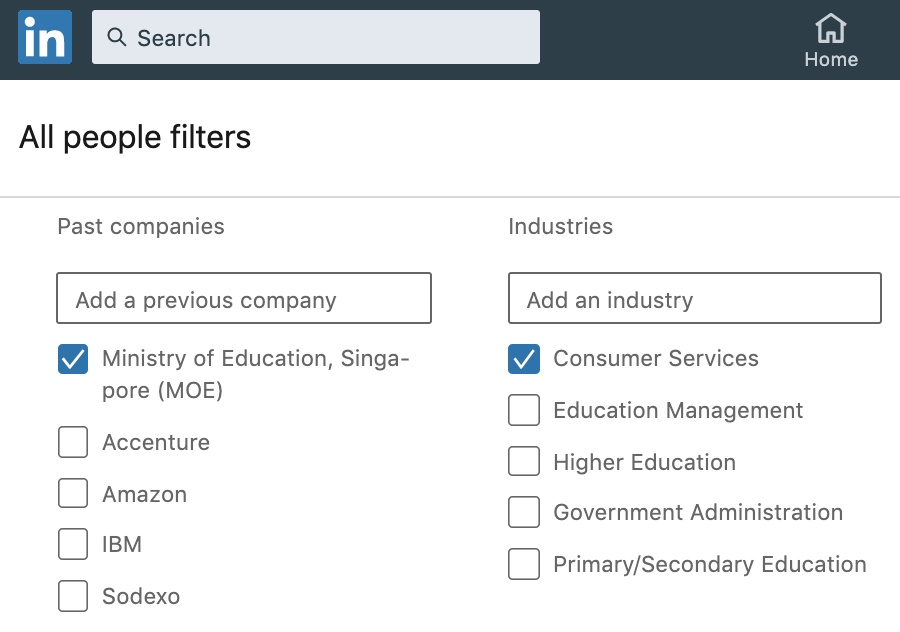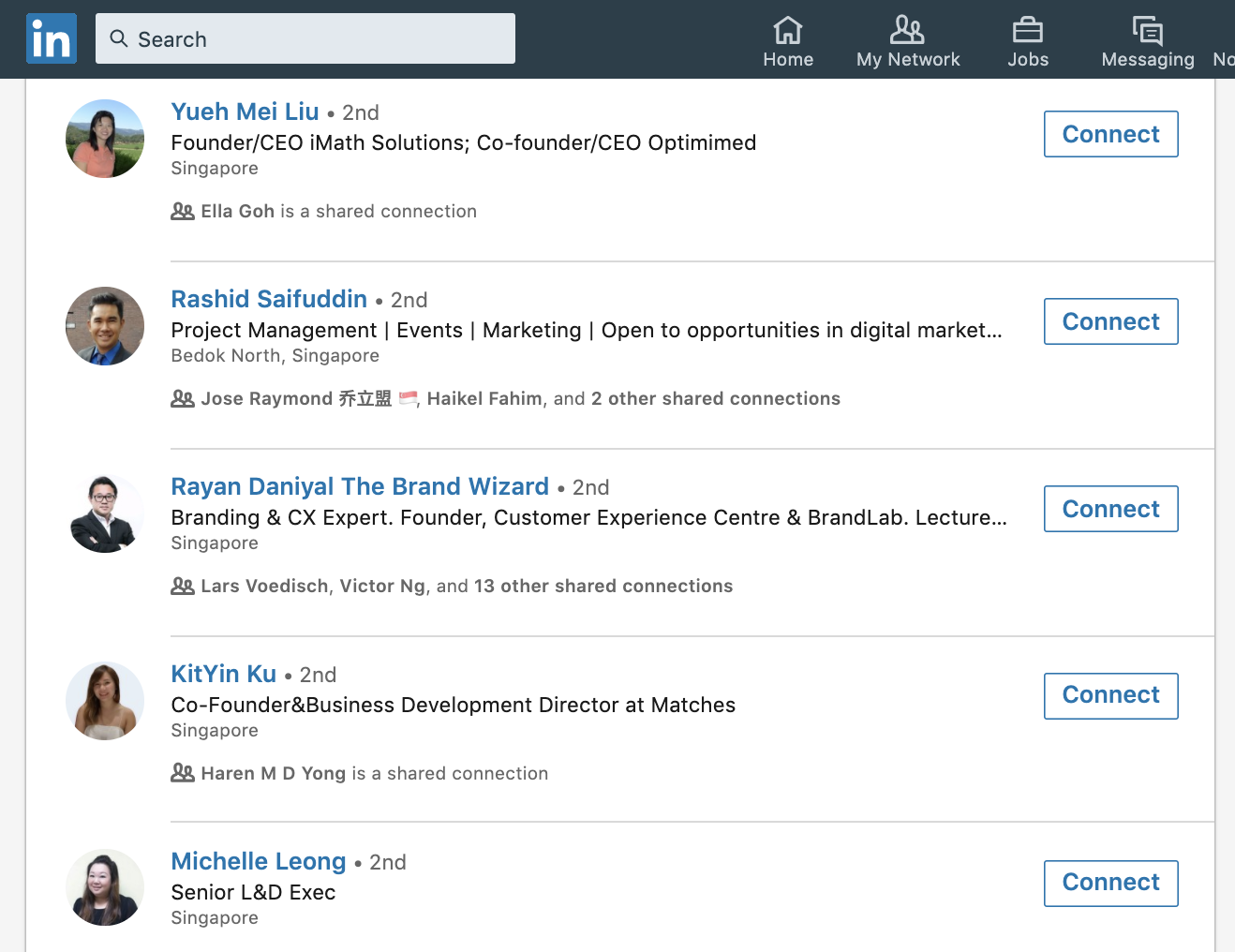How To Make A Mid Career Switch at 40

A physics researcher named Kenny from NUS reached out to us a few years ago. He wanted us to help him with a career change.
He’d spent years in academia and was nearing his 40s. The problem was that after 15 years, he was bored of physics.
Big data and tech was the new wave. Newspapers were touting this new occupation. The work was intellectually challenging, cutting edge and had an immediate impact.
It seemed like exactly what Kenny was looking for.
Unfortunately, he wasn’t getting any calls with his CV.
Thankfully, Kenny was a fighter. He didn’t give up. Fast forward to today, he’s now a Vice President of Data Science at one of the world’s largest advertising firms.
This is how he did it.
How to Make a Mid Career Change
- Network to figure out if it’s definitely for you
- Start applying on job boards
- Get credentials. Improve your CV for your career switch
- Start low. Get an internship
- Network your way in
- Once you’re ready, milk your network
1. Network to figure out if it’s definitely for you
A lot of us rely on gut instinct. The grass always seems greener on the other side. Steve jobs said to follow your heart.
In an optimistic country like the US, that might work. But HR departments in Singapore are much more cynical.
Make a wrong move in your career here, and you’ll be set back a few years.
Before you decide to make any career move, you need to be sure this is for you. Once you commit, there’s no turning back.
Thankfully for Kenny, a lot of the undergraduate and masters students he worked with at NUS were now working as Data Scientists.
And so he called them and met them for dinner.
One by one, he understood the struggles of the job, career prospects and learned first hand what online blogs don’t talk about.
Being an introvert, Kenny wanted work that didn’t involve a lot of client facing time. He enjoyed working in small teams, with other smart people, to tackle some really hard problems which would take weeks or months to solve.
The more he researched about Data Science, the more it seemed like a good fit for him.
He was sure this was his calling.
Now, he had to make it happen.
2. Start applying on job boards
With a bit of cursory reading, Kenny hit the job boards. He knew his chances were low, but he wanted to test the water first.
His strategy was this: If companies started calling him for interviews, he knew he wouldn’t have to waste time getting certifications.
If however, no one was calling him back, he knew he had to find a way to get the credentials to compete for this role.
The initial batch of job applications would serve as an early litmus test.
After 1.5 months, not a single company called him back.
Rather than sulk, Kenny viewed this positively. This is when he reached out to us.
3. Get credentials. Improve your CV for your career switch.
We were very frank with Kenny that this would be a very difficult switch, and that he had to do plenty of work on his own.
Thankfully, Kenny was very open to all our advice. We shared certifications which other Data Scientists we knew had (including some data science bootcamps). And one by one, Kenny got those certifications.
Most of these certifications were online. So Kenny could get them while holding his day job.
Two months later, he was ready with a new CV and a bunch of certifications. Naturally, we placed these data science certificates at the top of the CV.
4. Start low. Get an internship
Kenny’s strategy was to try to land a low full-time role at a company. If that didn’t work out, he’d settle for an internship.
Thankfully, our CV and job search strategy worked. Kenny managed to get a few calls.
Within 3 weeks, he was in a final round interview for a data science position. He passed the interview and received an offer. The role though wasn’t very exciting, and promotion prospects were bleak.
Instead, Kenny decided to take an internship at an American big data startup with an office in Singapore. The role would give him exposure to the latest data science frameworks. Something that really interested him.
Despite the significantly lower pay, Kenny recognised that this internship would give more learning opportunity. Logically, it was the smarter long term move.
5. Network your way in
Once he started working as an intern. Kenny could now say that he was doing actual, real world data science work.
He started going for data science conferences and meeting as many new people as he could.
At every event, Kenny came with a list of smart questions he wanted answers to. That way, he could ask these experts and get their inputs.
Books and blogs are great for information, but the latest and best knowledge is in the brains of actual industry practitioners. You had to speak to them to know.
(this is also very similar to algorithmic trading strategies in investment banking. You have to be in the industry to know what the latest standards are. By the time it’s published in a book, it’s already outdated)
Bit by bit, Kenny built a small network of smart people working in Data Science in Singapore. Thankfully, the community was small and friendly. This allowed him to gain a strong network very quickly.
6. Once you’re ready, milk your network
Everything was moving smoothly. The internship was going well, Kenny’s data science skills were improving, and he was networking with some great professionals.
And then, disaster.
The American big data startup he was interning for had a change in strategy.
Despite performing well, Kenny’s internship was cut short. He was now unemployed.
Thankfully, by this time, Kenny had built a good network. He quickly called up everyone he knew and explained to them that he was actively looking out for roles.
He published some of his work on his online Github repository so that his peers could see the quality of his coding.
By some stroke of luck, a friend he met at a conference managed to get him an interview for a senior role at his company.
The hiring manager loved Kenny’s detail orientated background. He was hired on the spot.
Funnily, this same company rejected Kenny 8 months earlier, for a more junior position.
Now, they were hiring him at a higher level, for 50% more salary. (it was 10% higher than his last drawn NUS researcher salary)
Key Takeaways
Truth be told, while our CV helped Kenny, the main reason he was so successful was because he listened to our job search strategy and stuck to it.
When navigating your career change, outline a similarly detailed strategy. There are a few questions you should definitely ask yourself while considering a career switch.
You’ll still need a lot of luck. Chances are, your interview will come through networking, and not through a front door application.
But your CV can help you get a toe in, like Kenny. Our CV got him that first crucial data science internship.
Nonetheless, people like Kenny prove that you can indeed make a career change at 40.
The employment market in Singapore is full of great opportunities. You just have to be hungry enough to fight for it.
ResumeWriter Tip: Sometimes, you need a longer break in order to reassess your career and life priorities. You might consider taking a sabbatical, a leave of absence, or leaving your current job.
Questions to ask yourself before making the switch
Before you get fired up, and shoot your resignation letter to your boss, here are a few things you should do or ask yourself:
1. Are there successful mid career switch case studies?
The short answer is – yes! Kenny’s story is proof of that.
But what about your specific industry? Has anyone successfully gone down the road you’re planning to take?
Well, desktop research is a great place to start!
With so much information available online, you can easily identify anyone who had taken a similar career path, and see how that’s working out for them.
Specifically, you can head to LinkedIn and search for people with these two fields: “Industries” and “Past Companies“

In my example, I’m assuming someone who’s currently a teacher wishes to make a career change and join the Consumer Services industry.
I can see quite a few results from this! I can then click into each of these to review their respective transition journeys.

There has to be something they’ve done right to be where they are today.
Isolate their commonalities and you should arrive at something you could use to reflect and review.
If you don’t get to see as many results as I do, that’s probably because you have fewer connections. (more on building up your LinkedIn network here!)
And if I were you, I’d get connected with these successful mid career switchers and seek their advice.
Just imagine – years ago they were in your shoes. They’ve been through that same emotional career switch roller-coaster you’re now experiencing.
Ask politely, and they might be open to helping someone – who reminds them of themselves – navigate this midlife career change, and avoid making the same mistakes they did.
You could write something like this:
Subject: Love to get your advice on career switch
Hi Emily
I chanced upon your profile as I was doing research on making a career switch.
Just like you, I’m currently a teacher who is looking to move into the Consumer Services industry. But I’m frankly lost, and don’t know where to start.
Given your successful transition, I hope you could give me some advice.
Let me know when and where is good. Coffee’s on me.
Regards
Harry
Don’t take up a job in another field without giving it in-depth consideration and doing lots of research.
Nothing is worse than leaping before you look.
You don’t want to end up in a field that makes you feel exactly what you did in your last.
2. Is this new career a good match for your skills and interests?
Do you actually possess the capabilities required for this career? Are your current skills easily transferable?
If not, are you willing to invest time and money to acquire the necessary skill sets?
Or are you totally unsure what the requirements are?
Then, what career is right for me?
Take an assessment test to find out. You can try using CareerExplorer.
Their career test is designed to measure a person’s traits and match them to ideal careers. The unique psychometric assessment measures people on 186 traits across 8 categories including, personality, needs, culture, interests, and abilities.
3. Money should not be the deciding factor
Money is important, but it shouldn’t be the key reason why you are making the move.
If it is, you might as well remain where you are, work your socks off, and become the best in your current function. Some other company will surely reach out to poach you.
I know of people who used to work in property, but decided to exit the industry due to cooling measures. They ventured into education and F&B.
Based on my understanding, their decisions were made purely because of the monetary potential they saw in those sectors.
The education venture has since folded, and the F&B one is still bleeding.
The key takeaway is – when you make a career switch, your passions and interests will sustain you.
Another person I know, a car enthusiast, went into the car grooming business when he left property.
Because of his immense interest, he did spectacularly well. Money’s rolling in till today.
So if your decision is purely money driven, think again. There are too many instances of such career switches not working out.
They just don’t get air time compared to rags-to-riches stories.
4. Do a career trial
Why not give it a try before you go all out?
It isn’t hard to try out what you want, even if you do not possess the skill sets.
Just do it for free, and learn as you go.
You could go to into Giving.sg and search for volunteer opportunities. Connect with the organisations, and help them with that function. It allows you to both gain experience AND do good at the same time.

You can also explore a Career Trial with Workforce Singapore
Gain experience through a short-term trial at a company, where you’ll be paid at least $1,500/month for full time position, $750/month for part-time position.
While you try out your new role, you’ll be assessed for potential longer term employment at the same time.
5. Acknowledge that a successful career change will take time
Finally, do be patient.
You can’t expect to change careers overnight, just as you can’t expect to be successful in one day.
A thorough career change usually takes a minimum of six months to pull off, and could stretch up to a year or more.
But if you’ve researched well beforehand, and are certain your new chosen career aligns with your strengths and interests, a mid career change could be well worth it 🙂
Bonus tip: Get help!
In Singapore, government agencies and employment centres provide lots of support to job seekers who are keen to make a career transition.
One of the avenues you can explore is e2i’s Place-And-Train Programme.
Under their Adapt and Grow initiative, Workforce Singapore also provides mid career change options for Singaporeans. You can look at some of the career conversion programmes that help train mid career professionals in a new field.
Their Professional Conversion Programmes (PCPs) give mid-career PMETs (Professionals, Managers, Executives and Technicians) opportunities to convert their skills, and enter growth industries by making use of their relevant qualifications.
Do also look out for career switch bootcamps like these (1, 2). They can be more intense, but they can give you a wider job scope and ultimately they offer more career transition opportunities.
Return to Ultimate Singapore Job Search Hub
- Top 10 Digital Marketing Courses in Singapore 2024 - October 17, 2024
- Top 10 Practical SkillsFuture Courses to Spend Your SkillsFuture Credits On - October 14, 2024
- What Is Sabbatical Leave? | How It Works in Singapore - September 1, 2024
